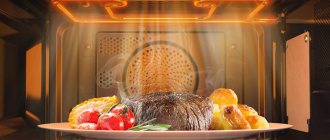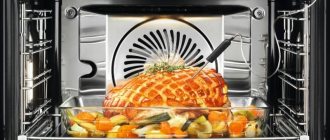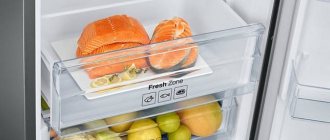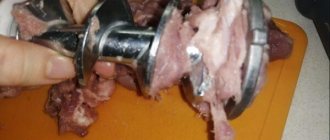Modern household appliances for the kitchen can perform a huge number of functions. Unfortunately, some of them, after purchasing a “sophisticated” oven or electric stove, remain unclaimed, but at the same time significantly increase the cost of the purchase. According to many, when buying a new oven, you should pay attention to the presence of a useful and even necessary operating mode - convection. Let's talk about what it is - convection in the oven, and why it is needed.
How the oven works
If your kitchen has a regular old model gas stove, then in its oven everything is arranged in such a way that it couldn’t be simpler: there are one or two burners located below, above which you can install shelves with baking sheets at different heights.
Heating occurs only from below, the upper part of the baked product is browned only in natural convection mode. By the term we mean the movement of heated air masses, accompanied by heat exchange.
In such an oven, this very often happens: on the one hand, on the far wall, the pies or roast have already begun to brown and burn, and the part located closer to the door has not even browned yet. You have to take out a baking sheet or pan and turn it over to even out the heat.
But not all types of tests can withstand such manipulations without consequences. For example, your sponge cake may well fall off. There is no need to talk about capricious meringues - baking meringues requires a very gentle regime so that the delicate protein foam does not settle.
A more modern gas stove may also have a top burner in the oven. Sometimes the top heating element may be electric and the bottom burner may be gas. Having an additional heat source greatly simplifies the cooking process. You can adjust the heat in the oven from above and below if necessary.
Even not the latest models of electric ovens have more than one heating element. But their presence does not ensure high-quality, uniform baking of the prepared products.
This happens because natural convection in a household oven occurs slowly and depends on other factors. For example, on the width of the baking tray placed. So if there are no gaps left on the sides, heated air from the bottom of the oven simply will not get into its upper part. In this case, the lower surface of the dough is doomed to burn, and the upper surface will remain unbaked.
And then a forced mode comes to the rescue - the convection mode. This is exactly the function that home appliance sellers praise so much when they offer you to buy an electric oven.
Electric
There is a generally accepted opinion that electric ovens bake better than gas ovens. This is true. This can be explained simply by the difference in design. In gas models, there is only one heat source - a burner located at the bottom of the chamber.
And in electric ones there are at least two, with one heating element heating from above, and the other from below, thereby ensuring uniform baking of the product. However, if you put two pies at once on different levels in such a cabinet, they will not bake equally. One will fry more strongly on top, the other on bottom, depending on which side is closer to the heating element.
Gas
As mentioned earlier, a gas cabinet only has one burner at the bottom, so even heat distribution is more difficult to achieve. First of all, they try to reduce heat loss by wrapping the chamber with insulating and reflective materials. Seal the gaps between the chamber and the door, installing 2-3 glasses in the latter.
Surely many housewives have noticed that there are holes made along the edges of the baking sheets. This is necessary so that the metal sheet does not interfere with the passage of heat, and it flows freely to the top. However, despite all these tricks, it is not always possible to achieve good baking.
This can be partly explained by the peculiarities of cooking with gas. During operation, combustion products are formed that must be removed. Therefore, in principle, the chamber in the oven cannot be sealed, and, therefore, heat loss cannot be avoided.
Safety of installation and operation
All models of gas ovens have several systems that ensure safe operation. So, the door glazing is made multi-layered so that the scalding temperature does not reach the outer surface of the door. So that even a child looking through the “porthole” at a chicken rotating on a spit will not get burned. He will not be able to participate in controlling the oven and opening the door, thanks to the lock.
In addition, as mentioned above, heat is removed from the surface of the oven by an internal electric fan.
The control panel of a gas device is much simpler than that of an electric one. In addition to the timer (1), the panel contains a temperature regulator (2) and a mode switch (3). Power on indicator (4)
The gas supply is blocked automatically if:
- the burner goes out accidentally;
- a gas leak occurs;
- The pressure in the gas line drops.
To install a gas oven, you must invite a specialist. He will not only safely connect the gas, but will also check the compliance of the technical device with the type of gas (natural or liquefied) and, if necessary, replace the nozzle.
Additionally, it is necessary to install exhaust equipment. To connect to the electrical network and gas, you need to contact specialists.
The electrical outlet must be of the correct type and must be grounded. In addition to the above, it is necessary to take measures to ensure free access to the oven and its removal. Therefore, it is important link_webnavoz]to properly prepare the place[/link_webnavoz].
What is convection in an oven
Convection is the transfer of heat by air currents. It is a Latin word that means "transfer." In simple terms, convection is when warm and cold air change places, the warm air rises and the cold air sinks.
Eventually, all layers mix and the temperature becomes the same everywhere. Perhaps someone remembers old ovens, in which the baking sheet had to be placed on the lower level first, and then raised higher so that the food did not burn from below.
So, in convection ovens there is no need to perform such manipulations. The heat will be evenly distributed immediately after heating, and the delicious pies will not burn. They will be cooked through in the middle and crispy on top, without being soggy or overcooked.
Moreover, you can put two or three baking sheets in one oven at the same time and even cook several dishes at once. Truly, this is the dream of every housewife. You save time, energy and have time to get everything done.
In older oven models, burners (gas) or heating elements (electric) were located only at the bottom, and the top of the baked goods was browned due to natural convection - the movement of heated air and heat exchange in the closed space of the oven.
The results were often disappointing: the bottom was burnt and the food was unevenly baked. I had to take out the baking sheets, turn them in different directions, and place a container of water on the bottom of the oven.
New oven models, as a rule, are also equipped with heating from above, which greatly simplifies the baking process and allows you to cook dishes on the grill. But even with combined heating (bottom and top), natural convection may not be enough for perfect baking.
The fact is that normal heat exchange in the oven occurs rather slowly; certain factors can interfere with it: a door that does not close tightly or opens it frequently, as well as large baking sheets that occupy the entire width of the oven and interfere with air circulation.
Convection (from Latin convectio - transfer) is a natural heat exchange in which internal energy is transferred by flows and jets. Warming air rises and cold air falls down.
In an oven, when layers of air are mixed more quickly due to convection, the temperature immediately becomes the same on all levels. Now any housewife can appreciate the advantages of ovens with forced convection, that is, air circulation created using a built-in fan.
It is usually located on the back wall of the oven and turns on separately when certain modes or preset programs are selected.
Various oven manufacturers offer improved convector designs that have additional features: fans with a separate heating circuit, reinforced fans to create a rapid flow of hot air, moist convection mode for steaming dishes without the use of fats.
What is forced convection
In this case, this means forced air circulation in the oven. The movement of hot air masses is provided by a fan.
In the closed space of the oven, the airflow creates a real vortex of hot air. This vortex evenly heats the product from all sides. Nothing else burns on the bottom; the top is covered with a beautiful crispy crust.
The fan is usually located on the back wall of the oven and is turned on separately.
Convector in this case means forced air circulation mode in the oven. The movement of hot air is provided by the ventilation element. In the closed space of the oven there is a real hot air blowing system.
- Convective heating while a dish is being cooked in the oven heats it up equally on all sides, therefore:
- nothing burns from the bottom;
- a magnificent fried crust forms on top;
- the dish will be completely cooked.
The forced convection system is usually located on the back wall of the oven. The fan can be turned on separately and prepare properly delicious baked dishes. After the end of cooking, the timer usually beeps, giving a signal.
Advantages
Convection mode is a convenient function that is needed by those who constantly cook different dishes in the oven. Its advantages:
- The temperature is evenly distributed.
- There is no need to change baking trays with food, as they will be baked well.
- Cooking becomes easier.
- At low heat, you can use this mode to defrost meat and fish.
- The fan allows you to quickly dry nuts, fruits or mushrooms.
- The oven heats up faster.
- You can cook several different dishes at once by adjusting the convection between them.
Also, different modes have their own advantages. Moist convection, for example, allows you to steam dishes, and enhanced convection quickly creates a crispy crust that preserves the juiciness of the product when baking.
What is convection in the oven for?
It allows you to successfully bake large pieces of meat, bake wonderful pies, make delicate meringues and even simply dry herbs, delicious candied fruits or crackers. You can even skip the heat by using just cold convection. And in combination with low heat, convection will allow you to quickly defrost meat or vegetables from the freezer.
The convection mode will allow you to use the entire volume of the oven with maximum efficiency: even if you put two or three baking sheets inside, everything will bake evenly.
- It is not necessary to use this function every time you cook. It can be turned on in cases where it is really necessary:
- to ensure a crispy crust;
- to dry out too much liquid released from baked products;
- for good baking of a large pie or poultry carcass.
The modern convection oven has various baking, grilling and defrosting modes. This allows you to cook several dishes at the same time, which significantly reduces gas (electricity) consumption and the amount of cooking time.
Detailed instructions from the manufacturer tell you how to configure the necessary parameters. So, convection is a function in which forced air circulation occurs inside the oven, due to which the same heating temperature is formed on all sides.
- To understand whether convection is needed in the oven, let’s look at the advantages of this function:
- Uniform temperature. Dishes are baked on all sides at once.
- Cooking several dishes at the same time.
- Replaces hobs. In some cases, such an oven allows you not to use standard hobs (in the country, in country houses, etc.).
- Minimizing electricity and gas consumption.
- Additional modes - for baking, defrosting, drying.
- Full control and security. You can always turn off the blowing function yourself.
Advantages
Many people ask why the convection mode is needed if meat is baked perfectly in the oven without it? Why turn it on and what dishes to cook with it? This question was partially answered in the previous section.
- A convection oven has a number of advantages:
- the dish is baked evenly;
- you can cook food on several baking sheets at once;
- you can do without a hob;
- less electricity or gas consumption;
- less oil consumption;
- The range of dishes that you can cook in the oven is expanding.
In the oven, meat and fish are defrosted with a stream of hot air, medicinal and spicy herbs are dried, nuts and lemon zest are dried. The oven makes excellent meringues and various pastries made from dough. If convection is not needed, then the mode is simply not turned on.
Indeed, how many times have housewives been faced with a situation where it is necessary to cook both a side dish and meat at the same time? And when you have to bake a cake from several layers? In the latter case, cooking was delayed for several hours: first the first cake was placed, when it was baked - the second, then the third, and so on.
It was only a dream to cook several cakes at the same time on different levels. In a convection oven, you can spread the dough on several baking sheets, and it will bake equally well on all of them.
Why else should you choose a device with convection? Not everyone knows that convection can be used to dry berries and herbs. How did you usually dry it in ovens before? We laid out the food on a baking sheet, turned on the minimum heat, and opened the door.
To prevent the berries from burning, you had to stir them regularly and monitor the temperature. If you use convection in the oven, everything becomes much simpler. The fan blows the greens and berries evenly, as a result they dry quickly and do not burn.
In this case, the upper and lower heaters do not need to be turned on at all - the convector is often adjacent to an additional low-power circular heating element, which is turned on together with the fan.
In ovens, convection is often combined with other heating methods. The more expensive the model, the more functions it has, the more combinations for preparing a variety of dishes it can have.
Devices with convection function
Gas convection oven
Gas stoves with built-in convection ovens are popular with many practical housewives. This is primarily due to the relatively low cost of fuel. Externally, such a stove is practically indistinguishable from an ordinary modern gas stove. However, a special fan is built into the back wall of such devices.
The convector in such a stove has a number of operating features. Since in these models the heating part is located at the bottom, before putting the dish in the oven for cooking, you must first turn on the convector for a short period, and then send the dish into the oven for cooking.
The disadvantages of this type include the lack of complete sealing of the oven, since it is necessary that combustion products have a constant outlet. This ultimately leads to longer cooking times.
Electric convection oven
Some housewives wonder how necessary convection is in the oven, because it itself is a fairly powerful fryer, capable of heating up to a temperature of several hundred degrees. In fact, even such a powerful flow of warm air is not capable of ensuring ideal uniformity of its distribution, and, accordingly, uniform cooking of the dish.
Today, voluntarily abandoning the convector in the oven is not a reasonable decision. It is thanks to him that it is possible to achieve ideal uniform baking of the dish, juiciness and crispy crust on the surface. It’s no wonder that models of electric stoves with convection are the most popular among buyers today.
Grill with convection
The grill function quite often comes as part of the options of modern stoves. The grill allows you to easily and efficiently cook meat on a spit. There are two types of grill:
- Gas. In this case, there is a high-quality imitation of cooking over coals.
- Electric. Its feature is more convenient operation.
Grill and convection combine perfectly and complement each other. There are two types of grills: air grill and turbo grill. The desired mode is very simply activated by pressing the corresponding button on the control panel. The advantage of using an air fryer is the ability to obtain high-quality roasted meat with a crust.
What is convection in a microwave oven
For a long time now, the microwave oven has become an integral part of the kitchen equipment set of most families. It allows you to quickly heat up various foods and semi-finished products, and defrost foods. Microwave ovens today also use convection quite often.
Moreover, in essence it does not differ from that in a standard oven, except for the size. The fan distributes air flow inside the chamber. When a certain temperature is reached, the system automatically turns off. The use of convection in microwave ovens can significantly reduce the time of defrosting and cooking food.
Types of convectors
Most often, your electric oven is provided with this opportunity by a fan of a simple design, the function of which is simply to drive air throughout the entire volume of the oven. A fan surrounded by an additional heating circuit is more efficient.
Some models of Miele electric stoves have a convenient wet convection function. When this mode is turned on, the air inside the oven is saturated with steam. Dishes don’t dry out, the dough rises better, and you can generally steam anything you want without harmful frying.
In Neff brand cabinets, manufacturers build in reinforced fans that create a rapid flow of hot air. Rapid heating gives a good effect in autumn: the product is quickly covered with a dried layer, which prevents the juices from evaporating during further baking.
All of the above applies to electric ovens. Until recently, the usual gas stove was deprived of a convenient forced mode.
But recently the Electrolux company launched a new product on the market: now a gas stove can be equipped with a fan. For now, only a free-standing gas stove can have this function, but it is not a fact that manufacturers will stop developing new models.
The fact is that a gas stove still outsells an electric one, at least when it comes to free-standing stoves. And the Russian market is no exception.
Gas in our country is still cheaper than electricity. Therefore, a gas stove is used in 80 out of 100 kitchens. Now those for whom a gas stove is more suitable will also be able to appreciate a gas oven with convection.
So, there are three popular types of stoves that are equipped with convection:
- Type 1. Gas stove + electric convection
- Several features of a gas stove with this function:
- Gas + electricity. Most often, models are produced in which the hob is powered by gas, and the oven is powered by electricity.
- Price. The cost of such a device is usually higher than one that runs entirely on electricity.
- Safety. When forced air circulation is operating, the gas supply is turned off.
- Type 2. Electric
On store shelves you can find a mini-sized electric oven. This is a fairly compact device that works when connected to the network.
An electric stove has limited space, so it can be difficult to cook several dishes inside at once.
- Type 3. Combined
Manufacturers are increasingly releasing models with mixed mode operation. This design allows you to cook with both electricity and gas.
Review of advantages and disadvantages
What are the advantages of convection ovens? Fast cooking is the main advantage. The directed flow of hot air transfers more heat to the food, so food cooks faster and more evenly. Cooking time for most dishes is about a quarter (25%) less. If you are cooking recipes designed for a conventional oven, be sure to recalculate the time before setting the timer.
Many chefs note that convection cooking is preferable for frying, since the golden brown crust on the meat is formed more evenly under the influence of circulating hot air. The juices remain inside the product, which makes the food more tender and tastier.
One of the advantages is the ability to cook several different products at the same time. Products are not saturated with the smells of “neighbors”. The main thing is not to overload the chamber space, making convection difficult.
Reducing cooking time means reducing energy costs, which means you save money. A reduction in time costs also occurs when several different dishes are being prepared at the same time. Saving energy and time is also achieved because there is no need to often open the oven to control the cooking process (when opening the door, the heat already gained is lost). Reduces the time and energy required to preheat the oven before loading food.
New opportunities are emerging. The ability to cook several dishes at the same time , defrosting and drying at low (up to 40°C) or room temperature.
Unfortunately, there are some drawbacks, the main one being the high price . GD models with a convection function are almost half as expensive as analogues that do not have it. If you cook a lot, often and with pleasure, and if the purchase of an expensive appliance does not cause significant damage to the family budget, such a generous “advance payment” will not cause later regrets.
Some products do not tolerate airflow during cooking, since the air flow is an external force that can destroy the fine structure formed during rise. For example, a “sissy” soufflé easily loses its shape, turning into something flat. Even cupcakes can lose their posture and become sideways. When preparing foods that require delicate handling, the convection function is turned off or set to minimum, slowing down the air flow.
In general, the convention function makes the cooking process more enjoyable, easier, and more economical. If you have to pay more when purchasing for models that have this function, then during operation there is a saving in costs
In any case, even if finances are not a significant argument when choosing an oven, you have to decide on your own whether you need convection in a household gas oven or whether you can do without it.
Having solved the dilemma in favor of a purchase, you can familiarize yourself with information about the operating modes of ovens, and also seek advice on choosing a particular model from a consultant.
How it works
In the oven, convection mode is possible thanks to the installation of a fan. It is the fan that moves and mixes layers of air. This mixing ensures the same temperature throughout the entire volume, as a result of which the dish is baked or fried evenly.
Most often, the fan is installed on the back wall of the oven. It circulates air, distributing heat evenly. When the desired internal temperature is reached, the fan turns off. Oven models are produced in which an additional heating circuit is installed around the fan. Due to this, the efficiency of the oven increases even more.
Electric convection ovens have dozens of functions that allow you to cook different dishes, defrost food, grill, and combine modes.
You yourself can choose the desired mode for the dish, depending on what the recipe requires and what result you want to get.
After reading the instructions, it is very easy to understand the control system. You can adjust the temperature, set the cooking time and the direction of the convection flow. Each function has its own icon.
Thus, cooking using convection with upper and lower heating turned on is indicated in the form of a stylized screw between two horizontal stripes.
Applying modes
At low temperatures (up to 150 ℃) or even without heating in convection mode, you can quickly and carefully dry fresh herbs, pieces of citrus peel, nuts, mushrooms or fruits (in particular, for uzvar - pre-peeled and cut into small flat pieces). Cold convection can also be used to defrost food.
At medium temperatures (160-220 ℃), convection provides an intense and impressive rise of products from most types of dough: yeast, sponge, shortbread, puff pastry, choux. With it you will get airy and dry inside eclairs, tender and light meringues, baked and rosy muffins.
An undoubted advantage of convection is the ability to use the entire volume of the oven to simultaneously prepare different dishes on several baking sheets.
When using the convection mode in the oven at high temperatures (from 220 ℃), large pieces of meat or poultry will retain internal juiciness, they will have a crispy crust, they will bake and fry evenly.
It is effective to use convection for drying juice if it is released in too large quantities, as well as for preparing dishes in portioned or large dishes, for example, in ceramic pots or a casserole dish.
The main differences between wet convection, enhanced and dry
- Type 1. Forced dry circulation.
The oven contains one or more fans, which may be surrounded by additional heating circuits.
- Type 2. Wet circulation.
In addition to the usual blowing, the air is saturated with moisture, thanks to which you can steam dishes.
- Type 3. Increased circulation.
A powerful fan creates a rapid flow of air, which allows the crust to set quickly and the inside of the food to remain juicy.
There should be a corresponding pictogram on the panel of both gas and electric stoves. It usually looks like a three-blade fan.
- Descriptions of other icons:
- Fan with underscore – blowing from below.
- With a zigzag on top - blowing + grill.
- Eco - wet circulation.
Free and forced convection
The movement of warm air masses itself, as noted above, is convection. But depending on what prompts them to circulate and mix, it is customary to distinguish between free (natural) and forced convection. Free convection occurs on its own in many processes, and occurs without external influence. Hot air becomes lighter, causing it to rise upward. Cold, being heavier – down. The efficiency and speed of such natural convection is much lower than that of forced or forced convection.
In the case of forced convection, air masses, under the influence of, for example, a special fan, circulate and mix much faster and more efficiently. As a result, hot air flows are fairly quickly distributed evenly in a confined space.
Convection mode in oven icon
If you bought an oven and never looked at its instructions, you can find out whether you have convection in the oven by looking at the icons and symbols on the control panel.
Depending on the oven model, the modes may vary depending on the combination of convection with the available heating options and the presence of steam.
The standard designation of convection modes includes a “fan” icon and a mark indicating the inclusion of individual heating elements (combined, selective - upper element only, lower element only, convection only).
Ovens with moist convection deserve special attention. They have built-in containers on the front or back wall, into which clean water is poured, and a steam generator.
In the humid convection mode, products are blown from all sides not just with evenly hot air, but with steam, which significantly speeds up the cooking process, helps maintain the juiciness of dishes, and reduces the amount of salt and fat. (A dream for all adherents of dietary and healthy eating!)
The most advanced models provide humidity control in several modes: hot steam (25%), intense steam (50%) and wet steam (100% - steamer mode). In this case, the moment of steam supply is automatically calculated by the program itself, but its quantity and frequency can be controlled manually.
There are options for different directions of the steam jet: distribution throughout the oven, on the dishes or on the products themselves through a special tube. Moist convection modes are convenient for sterilizing cans or baby food bottles. Convection in the oven is one of the indispensable functions of modern kitchen equipment.
It really expands your capabilities and provides enormous scope for culinary experiments. Now many traditional recipes are being revised taking into account new technological capabilities and are being adapted for convection ovens.
There is an opinion that convection in the oven allows you to reduce the temperature required for different types of baking by 10-15 ℃. Prepare your favorite dishes in a new way, come up with original recipes, make yourself and your loved ones happy!
The most useful programs
Normal convection. It is used for heating plates for the holiday, preparing (raising) dough before baking. Used for drying berries, herbs, sliced fruits and vegetables. It can also be chosen for baking juicy, minimally cooked foods suitable for dietary needs.
- A convector is useful if you need to defrost a large amount of food that will not fit in the microwave oven, for example, a Christmas turkey.
- Convector and bottom heater. This mode is used for cooking pizza, bread, pies. The main heat comes from below, baking the dough, and the hot air melts the cheese.
- Convector, bottom heater and grill. The mode is optimal for preparing frozen foods, including semi-finished products. This combination of heaters allows you not only to bake food, but also to form a golden brown crust on their surface.
- Turbo grill. In this mode, the convector, top heater and grill are turned on. Used for frying large pieces of meat, baking a crust on food.
It should be clarified that all of these modes, except the first, involve cooking at only one level. If you install several baking trays in the oven, the effectiveness of the combinations decreases.
Double convection
There are models in which two convectors are installed, located one above the other. This design is found in Samsung ovens, for example, Samsung BTS14D4T. Two fans distribute air more efficiently than one.
If in models with one convector the pies on different levels may turn out to be baked differently (on the middle tier the airflow is more intense, on the lower one less), then with two this problem will not arise. Each fan blows at its own level, so the food is baked at the same time.
It should be clarified that a convection oven should be purchased if the owner will regularly cook in this mode, since this function significantly increases the cost of the equipment.
Application of humid convection
Those who adhere to a healthy diet will be interested to know that some oven models have a moist convection mode. What is it for?
This mode allows you to steam food while preserving nutrients. Hot steam is supplied to the oven, so the food is not overcooked. It remains juicy and soft inside. The most famous brands offering such equipment are Electrolux, Miele, Smeg, Hansa.
In order for the wet convection mode to work in the oven, you need to pour water into a special container on the door or on the back wall. Once turned on, the water enters the steam generator and within a few minutes it will fill the oven.
- The important thing is that the steam jet can be directed in different ways:
- distributed throughout the entire volume of the oven;
- gets into the dishes;
- goes directly to products.
The steam jet supply time can be controlled. Using the wet convection mode, fish and vegetables are baked very tasty, you can prepare puff pie with a golden crust, heat up dishes, and sterilize jars and bottles for baby food.
Nuances of fan operation and shutdown
In electric ovens, the convection fan turns on during preheating, even if you are not using convection cooking. We wrote about connecting a gas stove with an electric oven here.
In gas stoves it does not turn on during this period. During convection cooking, the convector will typically run for about 10 seconds, then turn off for about 40-60 seconds. The working cycle of the convector in different modifications may vary, for example, work and rest for an equal amount of time.
Ways to turn off the fan
Because there are many different models of convection fans, the process for turning off the fan may vary.
Method #1 - turn off convection
Turn off the convection option . Some oven models have the ability to turn off the convection function. The fan turns off automatically.
Method #2 - open the door
In the design of many models, when the oven door is opened, the fan immediately turns off. It will turn on again when the door closes. To turn off the convector, open the oven door during cooking.
Method #3 - Cool the oven
Turn off the oven and let it cool. During cooling, the fan may remain on for a while. It will eventually turn off.
A tangential cooling fan is also called a diametrical fan. It creates a uniform, flat flow of cooling air. The fan performs double movement of the air flow perpendicular to the axis of the rotating impeller
The cooling fan is supposed to run until the oven cools down.
Method #4 - Switch Oven Settings
If you have a combination oven with a conventional oven, switch the setting to normal operation. If the oven is a combination oven, changing to the normal setting according to the manufacturer's instructions will usually result in the fan turning off.
Method #5 - click the button
In addition to an internal fan that moves heat around the food area, some convection ovens have an exhaust fan to remove fumes, smoke and odors from the cooking area.
The device may have a control for selecting settings, for example, high, medium or low, or one button that is pressed to turn the hood off or on. To turn off the exhaust fan, press the off button on the front of the unit.
When should I contact the service center?
In general, fans installed in gas ovens are reliable equipment, designed to last for many years.
But there are signs, if present, you should immediately contact a service center:
- you can hear creaking, extraneous noise, or knocking when the oven is operating;
- The cooling fan never turns on;
- an unpleasant odor or smoke is heard from the cleaned oven.
Let's take a closer look at the features of these breakdowns.
Firstly, convectors operate not completely silently, but quite quietly. If your fan makes an abnormal sound, such as squealing, squeaking, or knocking, especially when it stops or starts, you should contact a professional immediately. If the reversible convector simply pulled in a piece of foil, and it is easily removed, then the problem can be fixed on your own.
Secondly, the cooling fan is usually not visible, but you will hear it running. When the electronics heat up, it will turn on, when the electronics cool down, it will turn off. The oven or cooktop generates enough heat to turn on the cooling fan. If the cooling fan never turns on or off, you should visit a service center.
The third sign to contact the service center is if you notice an unusual odor or smoke coming from the oven when it is completely clean
Features of gas ovens
Gas ovens with a fan are produced less frequently and are usually more expensive. But the savings when operating such devices are obvious. You can use gas, which is cheaper, plus the convection mode allows you to further reduce costs.
Among the companies producing gas ovens with an air mixing function are Zanussi, Kaiser, and Korting OGG.
The peculiarity of gas ovens with convection is that safety measures must be observed. The design of the device must be such that when the flame is blown out, the gas is turned off. Manufacturing companies have taken care of safety, so you can safely buy household appliances.
What's good about a convection oven?
A convection oven has a number of advantages, namely:
- All ingredients are baked evenly.
- It is possible to cook dishes on several baking sheets at the same time.
- Using this function, you can achieve a crispy, crispy crust.
- Reducing energy consumption.
- The use of oil when cooking is kept to a minimum.
- Possibility of preparing a varied menu.
So we figured out what convection is. When using this function in an electric oven, it becomes possible to expand the list of prepared dishes and improve the quality of baking. Nothing will burn and everything will bake evenly!
Convection is the circulation of cold and hot air.
When buying a new gas stove at a hardware store, I was urged to pay attention to multifunctional models that feature air convection. I wonder how necessary this mode is? Let's figure out together why convection is needed in the oven.











